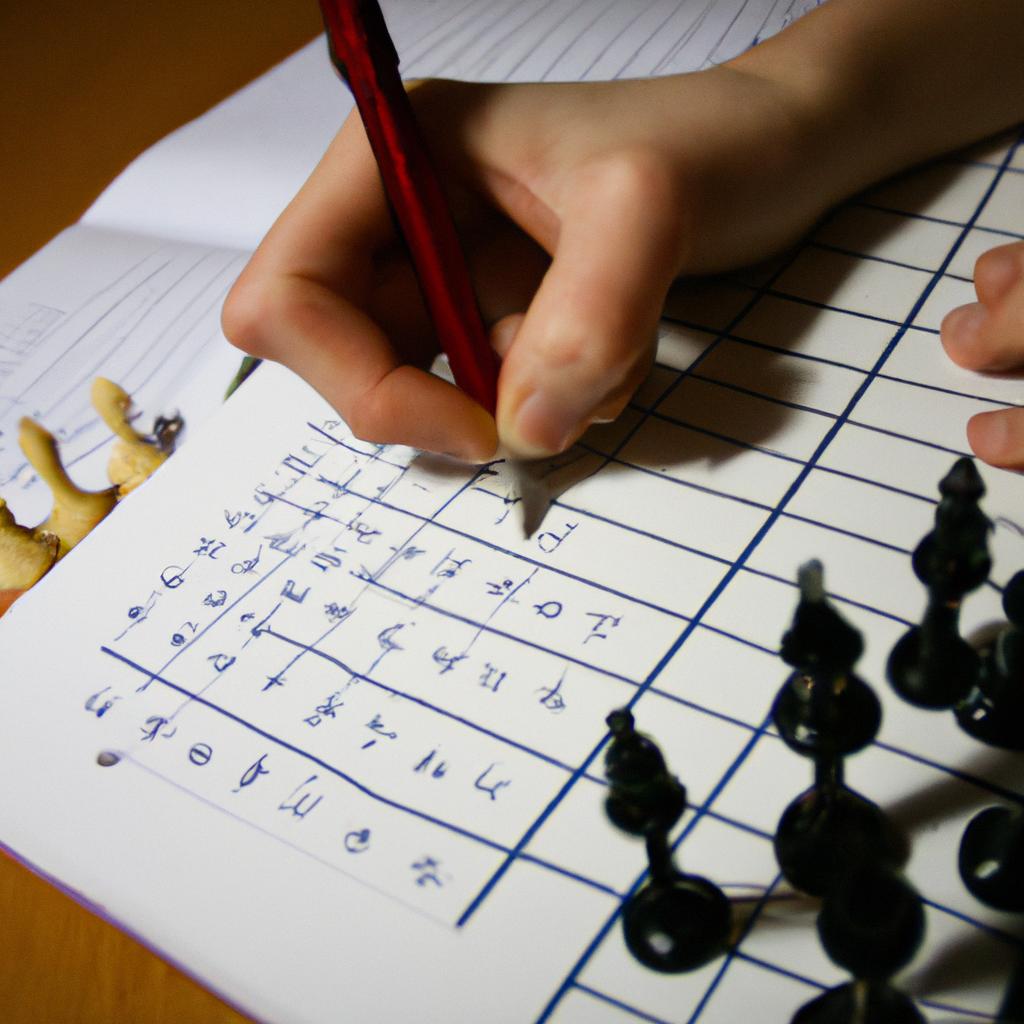Chess notation is a system of recording moves and positions in the game of chess. It serves as a language that allows players to communicate and analyze their games, as well as study and learn from the games of others. For example, imagine two skilled grandmasters engaged in an intense battle on the chessboard. As they make their moves, each player meticulously records them using chess notation, capturing every strategic decision and tactical maneuver with precision and clarity.
The use of chess notation extends beyond just the realm of chess. Many other sports and board games have adopted similar systems to record moves and actions. From bridge to tennis to video games like Fortnite, these notations serve as a common language for players and spectators alike. Understanding how to read and interpret this specialized form of communication opens up a world of opportunities for analysis, improvement, and appreciation of various games and sports.
In this article, we will delve into the fascinating world of chess notation – its history, conventions, symbols used, and practical applications across different disciplines. We will explore how it enables players to review their own performances objectively, study notable matches throughout history, and even contribute to ongoing research in artificial intelligence. By understanding the intricacies of this unique language, readers can gain a deeper insight into the complexities of the game of chess and enhance their overall understanding and enjoyment of the sport.
One of the key aspects of chess notation is its ability to capture both the moves made by players and the resulting positions on the board. This allows for precise analysis and evaluation of different strategies, tactics, and positional advantages in a game. By studying annotated games, players can learn from the techniques and thought processes employed by experienced players, improving their own skills and decision-making abilities.
Chess notation also plays a crucial role in competitive play. In tournaments, players are required to record their moves as they make them, ensuring accuracy and fairness during post-game analysis or disputes. Additionally, it enables spectators to follow along with the game, either in real-time or through recorded broadcasts. This creates a sense of engagement and involvement for those watching, enhancing the overall experience of chess as a spectator sport.
Beyond chess itself, understanding chess notation can have practical applications in various fields. For example, researchers in artificial intelligence use vast databases of recorded games to train computer programs to play chess at an advanced level. By analyzing patterns and strategies encoded in these notations, AI systems can improve their gameplay algorithms and generate new insights into the game’s complexities.
In conclusion, chess notation is an essential tool for recording moves and positions in chess. It serves as a common language for players to communicate, analyze games objectively, study historical matches, and contribute to ongoing research in artificial intelligence. Whether you are an avid player looking to improve your skills or simply interested in learning more about this intricate game, understanding chess notation opens up a world of opportunities for growth and appreciation within the realm of chess and beyond.
Understanding Chess Notation
Imagine yourself sitting in a crowded chess tournament hall, observing two players battling it out on the board. As you watch their every move with anticipation, have you ever wondered how these moves are recorded and communicated? Enter chess notation, an essential language that allows players to record and analyze their games systematically. In this section, we will delve into the intricacies of understanding chess notation.
To grasp the concept of chess notation, let’s consider a hypothetical scenario: a game between two seasoned grandmasters, Anna and Boris. Throughout this match, each move they make is meticulously documented using algebraic notation – the most widely used form of recording chess moves today. For instance, if Anna begins by moving her King’s pawn forward two squares (e2 to e4), this would be written as “1.e4.” Here, the number 1 signifies that it is White’s first move.
Now that we have established an example, let us explore why mastering chess notation is crucial for all serious players:
- Precision: Chess notation provides a precise method for documenting each move made during a game. This precision allows players to recreate and analyze their games accurately.
- Communication: When studying or discussing specific positions or strategies with other players or coaches, being able to communicate moves effectively through notation becomes indispensable.
- Learning Resource: By keeping records of our own games in notation format, we create a valuable resource for further analysis and improvement. These records allow us to identify patterns and mistakes while learning from both wins and losses.
- Historical Documentation: Chess notation preserves historical games played by legendary players throughout centuries. Analyzing these past encounters helps current players deepen their understanding of strategy and tactics.
In addition to bullet points highlighting its significance, another effective tool in conveying information is tables. Consider the following table summarizing different types of chess notations:
| Notation Type | Description |
|---|---|
| Algebraic Notation | Most widely used notation system, expressing moves with letters and numbers. |
| Descriptive Notation | Older notation system, using descriptive language to indicate moves. |
| Coordinate Notation | Uses coordinates on the board (e.g., e2-e4) to represent each move. |
With a fundamental understanding of chess notation’s importance and different types available, we can now delve into its historical roots. The subsequent section will explore the fascinating history behind this universal language of chess strategy and tactics.
Now that we have explored the significance of chess notation and presented an overview of different types, let us proceed to unravel the captivating history that surrounds this universal language in our next section: “History of Chess Notation.”
History of Chess Notation
Understanding Chess Notation is crucial for players to effectively communicate and analyze their moves. This section will delve into the history of this unique language, tracing its origins and evolution over time.
To illustrate the significance of chess notation, let’s consider a hypothetical scenario: two skilled grandmasters engaged in an intense tournament match. As spectators watch with bated breath, they can follow the game using a score sheet that displays the intricate sequence of moves made by each player. Without understanding chess notation, one would be left bewildered as the game unfolds before their eyes.
The complexity of chess necessitates a standardized system for recording moves, which led to the development of chess notation. This form of communication allows players to record and share their games with others, enabling analysis and study across generations. Moreover, it serves as a powerful tool for documenting historical games played by renowned masters.
Delving deeper into the world of chess notation, we encounter several key aspects:
- Algebraic Notation: The most widely used method today involves representing each square on the board with a unique combination of letters and numbers.
- Coordinate System: By assigning each square coordinates based on rows (ranks) and columns (files), players can precisely identify every move made during a game.
- Annotations: Alongside recording moves numerically or algebraically, players often supplement their notations with symbols denoting important actions such as captures (!), good moves (?), mistakes (?, ??), or brilliant moves (!!).
- Castling Indicators: A vital aspect of chess notation lies in capturing castling maneuvers accurately—designating whether it was kingside (O-O) or queenside (O-O-O).
This exploration into Understanding Chess Notation provides essential insights into how this language has become an integral part of chess culture. In our next section about Types of Chess Notation, we will examine different variations employed throughout history to further comprehend the rich tapestry that surrounds this fascinating subject matter.
Types of Chess Notation
Having explored the history of chess notation, we can now delve into its various types and their distinctive features.
One prominent type of chess notation is Algebraic Notation. This widely-used system represents each square on the board with a combination of a letter and a number. For instance, if the white player moves their pawn from e2 to e4, it would be recorded as “e4” in algebraic notation. Similarly, capturing another piece would be denoted by an ‘x’ symbol between the starting and ending squares (e.g., Nxe5 for a knight capturing on e5). Algebraic notation is concise, easy to understand, and allows players to record every move accurately.
Another form of chess notation is Descriptive Notation. Historically popular but less commonly used today, this system describes chess moves using descriptive language based on the initial position of pieces. For example, moving a pawn from King’s Bishop 3rd file to Queen’s Bishop 3rd file would be noted as P-QB3. While descriptive notation has certain elegance due to its traditional nature, it lacks the clarity and universality found in other notations like algebraic.
Forsyth-Edwards Notation (FEN) provides yet another method for recording chess games. FEN employs a string of characters that represent information about the position of all pieces on the board along with additional data such as castling rights and en passant captures. Although primarily used for computer analysis or database storage rather than live game recording, FEN offers precise details about any given position without requiring extensive annotations.
| Type | Representation | Features |
|---|---|---|
| Algebraic | e4 | Concise; accurate |
| Descriptive | P-QB3 | Traditional; lacks universality |
| Forsyth-Edwards | rnbqkbnr/ppppp1pp/8/5p2/… | Detailed; for computer analysis |
This exploration of the different types of chess notation demonstrates how each system has its unique characteristics, catering to diverse preferences and purposes. From the concise algebraic notation to the descriptive elegance of traditional systems like descriptive notation, players have options when it comes to recording their moves accurately.
Understanding the various types of chess notation sets a strong foundation for appreciating the benefits that come with learning this language. In the following section, we will explore these advantages in detail, highlighting why chess notation is not only valuable for players but also for enthusiasts and analysts alike.
Benefits of Learning Chess Notation
Types of Chess Notation: A Closer Look
Imagine a scenario where two chess players are engaged in an intense match. As they make their moves, you notice one player meticulously recording each move on a sheet of paper. This is the essence of chess notation – a system that allows players to document and analyze their games. In this section, we will delve into the different types of chess notation used by players worldwide.
There are primarily two main types of chess notation: algebraic notation and descriptive notation. Algebraic notation, also known as standard or coordinate notation, is widely regarded as the more modern form of recording moves. It involves using letters for columns (files) and numbers for rows (ranks). For example, if a pawn were moved from e2 to e4, it would be recorded as “e4.” Descriptive notation, on the other hand, was popularized in older literature but has largely fallen out of use today due to its complexity. It denotes squares based on positioning relative to the board itself rather than coordinates.
Let’s take a closer look at these two types through a comparison:
Algebraic Notation
- Uses letters for columns and numbers for rows.
- Easily understood and universally accepted.
- Allows for precise analysis using computer programs.
- Streamlined approach favored by professional players.
Descriptive Notation
- Refers to positions based on relationships between pieces.
- More challenging to learn and comprehend initially.
- Requires additional information like piece abbreviations.
- Less commonly used nowadays due to its complexity.
Understanding the differences between these notations can help aspiring chess players choose which system best suits their needs. Whether you opt for the simplicity and universality of algebraic notation or embrace the traditional charm of descriptive notation, both systems serve the purpose of documenting games effectively.
In our next section about Common Notation Symbols, we will explore some key symbols frequently encountered when reading or writing chess notation. By familiarizing ourselves with these symbols, we can deepen our understanding of the language of chess and expand our ability to analyze games effectively. So let’s dive into this fascinating world of symbolic representation in chess!
Common Notation Symbols
Transitioning from the previous section on the benefits of learning chess notation, let us now delve into a discussion on common notation symbols. Understanding these symbols is essential for effectively communicating and recording moves in a game of chess. To illustrate their significance, consider this hypothetical scenario: Two experienced players engage in an intense match, with each move being carefully plotted and executed. As they write down their moves using notation symbols, spectators eagerly observe the unfolding game.
The language of chess notation relies heavily on commonly used symbols to represent various aspects of the game. These symbols serve as signposts that guide both players and observers through the intricacies of each move. Here are some frequently encountered notation symbols:
- The pawn symbol (♙): Represents a pawn’s movement.
- The bishop symbol (♗): Denotes the movement of a bishop across diagonal lines.
- The rook symbol (♖): Signifies horizontal or vertical movements made by a rook.
- The checkmate symbol (#): Indicates that one player has successfully put their opponent’s king in checkmate, thus winning the game.
To further comprehend how these symbols function within notational systems, we can examine them in context within a table:
| Symbol | Meaning |
|---|---|
| ♟ | Pawn |
| ♝ | Bishop |
| ♜ | Rook |
| ♚ | King |
As you can see from this representation, each symbol corresponds to a specific piece or outcome within the chess game. This clarity facilitates communication between players and allows for efficient analysis and study afterward.
By familiarizing yourself with these common notation symbols, you will be better equipped to follow along when observing high-level games or analyzing your own matches. Additionally, understanding these symbols opens up opportunities for more advanced strategies and tactics during gameplay.
Transitioning seamlessly into our next section about practical applications of chess notation, it becomes evident that the knowledge of these symbols is crucial for exploring the wider world of chess analysis and strategy.
Practical Applications of Chess Notation
Transitioning from the previous section on common notation symbols, let us now delve into practical applications of chess notation. To illustrate its significance in real-life scenarios, consider a hypothetical situation where two renowned grandmasters are competing against each other in a high-stakes tournament. As spectators eagerly follow their moves, they rely on chess notation to understand and analyze the game’s progression.
Practical Application Example:
In a critical moment of the match, Grandmaster A sacrifices their queen to deliver checkmate with a stunning combination. The audience watches intently, following along using chess notation to decipher this intricate sequence of moves. This example showcases how essential understanding and utilizing chess notation can be for both players and enthusiasts alike.
The value of chess notation extends beyond simple record-keeping; it offers several benefits that enhance gameplay and analysis:
- Efficient Communication: Chess notation allows players to effectively communicate their strategies without requiring verbal explanations or lengthy discussions.
- Precise Analysis: By recording moves accurately, players can later review their games objectively, identifying strengths, weaknesses, and areas for improvement.
- Historical Preservation: Chess notation serves as an invaluable tool for preserving notable games throughout history, enabling future generations to study and appreciate the brilliance displayed by past masters.
- Global Standardization: With standardized algebraic notations used worldwide, players from different countries can easily share and understand recorded games regardless of language barriers.
To further emphasize the importance of chess notation in practical use cases, we present a table showcasing some famous games annotated with algebraic notations:
| Game | Date | Notation |
|---|---|---|
| Fischer vs. Spassky | 1972 | 1.e4 c5 2.Nf3 d6… |
| Kasparov vs. Karpov | 1985 | 1.e4 e5 2.Nf3 Nc6… |
| Capablanca vs. Marshall | 1918 | 1.e4 e5 2.Nf3 Nc6… |
| Carlsen vs. Anand | 2014 | 1.e4 c5 2.Nf3 d6… |
By studying these annotated games, chess enthusiasts can gain insights into the strategies employed by renowned players and develop their own skills.
In summary, practical applications of chess notation extend beyond mere record-keeping; it provides a means for effective communication between players, facilitates precise analysis, preserves historical games, and promotes global standardization. As we continue exploring the fascinating world of chess notation, its significance in both professional matches and casual play becomes increasingly evident.










